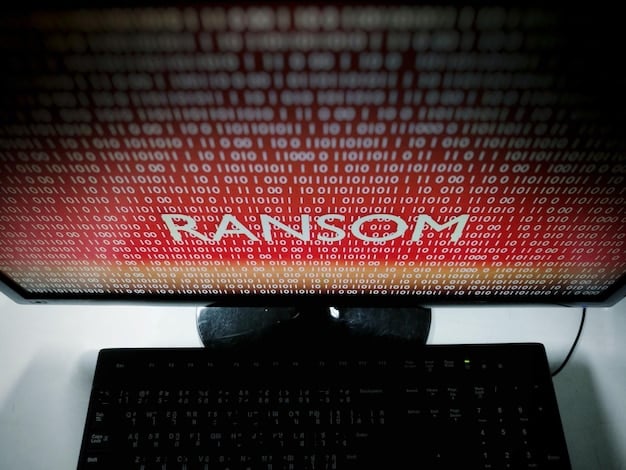Is DeFi a Good Investment for US Investors in 2025?

Decentralized Finance (DeFi) presents both opportunities and risks for US investors in 2025, with its viability depending on regulatory developments, technological advancements, and individual risk tolerance.
Is Decentralized Finance (DeFi) a Viable Investment Option for US Investors in 2025? The world of cryptocurrency is constantly evolving, and DeFi is at the forefront, promising high returns and innovative financial services. However, for investors in the United States, navigating this landscape requires careful consideration.
Understanding Decentralized Finance (DeFi)
Decentralized Finance, or DeFi, is revolutionizing traditional financial systems by using blockchain technology to create open, permissionless, and transparent financial services. Imagine a world where you can borrow, lend, trade, and invest without intermediaries like banks or brokers.
DeFi operates through decentralized applications (dApps) built on blockchain networks, primarily Ethereum. These dApps use smart contracts—self-executing agreements written in code—to automate financial processes. This automation reduces costs, increases efficiency, and makes financial services accessible to a broader audience.
Key Components of DeFi
Understanding the basic building blocks of DeFi is crucial for any investor.
- Decentralized Exchanges (DEXs): These platforms allow users to trade cryptocurrencies directly with each other, without a central authority.
- Lending and Borrowing Platforms: Users can lend their crypto assets to earn interest or borrow assets by providing collateral.
- Stablecoins: These cryptocurrencies are designed to maintain a stable value, often pegged to a fiat currency like the US dollar, reducing volatility.
- Yield Farming: This involves staking or lending crypto assets in DeFi protocols to earn rewards in the form of additional cryptocurrency.
By understanding these components, investors can better assess the risks and rewards of participating in DeFi protocols.
DeFi’s allure lies in its potential to democratize finance, offering greater control and access to financial services for individuals worldwide. However, this new paradigm also introduces complexities and risks that investors must carefully consider.
The Current DeFi Landscape in the US
The DeFi landscape in the US is a mixed bag of innovation and regulatory uncertainty. While the potential for high returns has attracted many investors, the lack of clear guidelines from regulatory bodies like the SEC and CFTC poses significant challenges.
Several DeFi projects, despite their global focus, are already making inroads in the US market. These platforms offer various services, including lending, borrowing, and trading, often with higher interest rates than traditional financial institutions. For US investors, this presents an opportunity to diversify their portfolios and potentially earn higher returns.
Challenges and Regulatory Hurdles
However, the regulatory climate in the US is a major concern. The SEC has been scrutinizing DeFi projects, seeking to determine which ones fall under its jurisdiction. This uncertainty has led to some projects scaling back their services in the US or taking a more cautious approach.

- Securities Laws: The SEC is concerned that some DeFi tokens may be unregistered securities, potentially violating US securities laws.
- Anti-Money Laundering (AML) Regulations: DeFi platforms must comply with AML regulations to prevent illicit activities.
- Tax Implications: The IRS is still developing guidance on how to tax DeFi transactions, creating confusion for investors.
Navigating these regulatory hurdles requires careful planning and due diligence. Investors should consult with legal and tax professionals to ensure they comply with all applicable laws and regulations.
Despite these challenges, the US remains a key market for DeFi. Many believe that clear regulatory frameworks will eventually emerge, providing greater clarity and stability for the industry.
Potential Benefits of DeFi Investing in 2025
Investing in DeFi in 2025 could offer several compelling benefits for US investors. The potential for high returns, increased financial inclusion, and innovative financial products are just a few of the reasons why DeFi is gaining traction.
One of the primary attractions of DeFi is the potential for earning high yields on crypto assets. DeFi platforms often offer significantly higher interest rates than traditional savings accounts or bonds. For example, staking certain cryptocurrencies or participating in yield farming can generate substantial returns.
- High Yields: Earn significantly higher interest rates compared to traditional savings accounts.
- Financial Inclusion: Access financial services without the need for traditional intermediaries.
- Innovation: Participate in cutting-edge financial products and services.
DeFi also promotes financial inclusion by providing access to financial services for individuals who may be excluded from traditional banking systems. This is particularly relevant in underserved communities where access to credit and banking services is limited.
Moreover, DeFi fosters innovation by creating new financial products and services that were not previously possible. Examples include flash loans, decentralized insurance, and tokenized assets.
However, it’s important to remember that these potential benefits come with risks. Investors should carefully evaluate their risk tolerance and conduct thorough research before investing in DeFi.
Risks Associated with DeFi Investing
While DeFi offers promising opportunities, it also comes with significant risks that US investors need to be aware of. These risks include smart contract vulnerabilities, regulatory uncertainty, and impermanent loss.
Smart contract vulnerabilities are a major concern in DeFi. Since DeFi applications rely on smart contracts, any flaws or bugs in the code can lead to significant financial losses. Hackers can exploit these vulnerabilities to steal funds or manipulate the system.

Understanding the Downsides
- Smart Contract Vulnerabilities: Bugs in code can lead to significant financial losses.
- Regulatory Uncertainty: Lack of clear guidelines can impact the viability of DeFi projects.
- Impermanent Loss: Temporary divergence in asset prices can reduce liquidity provider profits.
Regulatory uncertainty also poses a risk to DeFi investors. The lack of clear regulatory frameworks in the US means that DeFi projects could face legal challenges or be forced to shut down. This uncertainty can negatively impact the value of DeFi tokens and investments.
Impermanent loss is another risk associated with providing liquidity to decentralized exchanges. It occurs when the price of assets in a liquidity pool diverges, resulting in a temporary loss of value for liquidity providers.
Investors should carefully consider these risks and take steps to mitigate them. This includes diversifying their portfolios, conducting thorough research, and using DeFi platforms with robust security measures.
Strategies for US Investors in 2025
For US investors considering DeFi in 2025, a strategic approach is essential to navigate the complexities and risks. This involves diversification, due diligence, risk management, and staying informed about regulatory developments.
Diversification is a key strategy for managing risk in DeFi. Investors should diversify their portfolios across different DeFi projects and asset classes to reduce their exposure to any single project or asset.
Due diligence is also crucial. Investors should thoroughly research DeFi projects before investing, paying close attention to the team, technology, security measures, and regulatory compliance.
- Diversification: Spread investments across different DeFi projects and asset classes.
- Due Diligence: Thoroughly research projects before investing.
- Risk Management: Implement strategies to protect against potential losses.
Risk management involves implementing strategies to protect against potential losses. This includes using stop-loss orders, setting aside a portion of their portfolio as a risk buffer and understanding the terms and conditions of DeFi protocols.
Finally, it’s important for US investors to stay informed about regulatory developments in the DeFi space. By keeping abreast of the latest news and guidelines from regulatory bodies like the SEC and CFTC, investors can better assess the risks and opportunities in DeFi.
By following these strategies, US investors can increase their chances of success in DeFi while mitigating potential risks.
Future Outlook for DeFi in the US
The future of DeFi in the US is uncertain but promising. As the technology matures and regulatory frameworks evolve, DeFi has the potential to transform the financial landscape, offering greater access, efficiency, and innovation.
One of the key factors that will shape the future of DeFi is regulatory clarity. As regulatory bodies like the SEC and CFTC develop clear guidelines for DeFi projects, it will provide greater stability and confidence for investors.
Technological advancements will also play a crucial role. As blockchain technology improves, DeFi platforms will become more scalable, secure, and user-friendly.
- Regulatory Clarity: Clear guidelines will provide stability and confidence.
- Technological Advancements: Improvements in blockchain technology will enhance scalability and security.
- Institutional Adoption: Increased participation from institutional investors will drive growth and legitimacy.
Institutional adoption is another factor that could drive growth in DeFi. As institutional investors become more comfortable with DeFi, they will bring significant capital and expertise to the industry.
Overall, the future of DeFi in the US depends on a combination of regulatory clarity, technological advancements, and institutional adoption. While there are challenges to overcome, the potential benefits of DeFi are too significant to ignore.
The evolution of DeFi will likely involve a more integrated and user-friendly experience, bridging the gap between traditional finance and decentralized systems.
| Key Point | Brief Description |
|---|---|
| 💰 High Yields | DeFi offers potentially higher returns than traditional investments. |
| ⚠️ Risks | Smart contract vulnerabilities and regulatory uncertainty are key concerns. |
| ⚖️ Regulation | Regulatory clarity is crucial for DeFi’s future in the US. |
| 🧑💼 Strategies | Diversification and due diligence are essential strategies for US investors. |
FAQ
▼
DeFi, or Decentralized Finance, uses blockchain to offer financial services without traditional intermediaries. It operates via dApps and smart contracts, automating transactions and reducing costs.
▼
DeFi offers the potential for high yields, increased financial inclusion, and access to innovative financial products. Staking and yield farming can generate substantial returns.
▼
Key risks include smart contract vulnerabilities, regulatory uncertainty, and impermanent loss. These can lead to financial losses and should be carefully considered.
▼
Strategies include diversifying portfolios, conducting thorough due diligence, and using platforms with robust security. Staying informed about regulatory changes is also vital.
▼
The future depends on regulatory clarity, technological advancements, and institutional adoption. As these factors evolve, DeFi could transform the financial landscape.
Conclusion
In conclusion, Decentralized Finance (DeFi) presents a complex landscape for US investors in 2025. While high yields and financial innovation are attractive, the risks associated with smart contracts and regulatory uncertainty cannot be ignored. A strategic approach, including diversification, due diligence, and staying informed about regulatory developments, is essential for navigating this evolving space. For US investors, the viability of DeFi as an investment option ultimately depends on their risk tolerance, investment goals, and the evolving regulatory environment.





